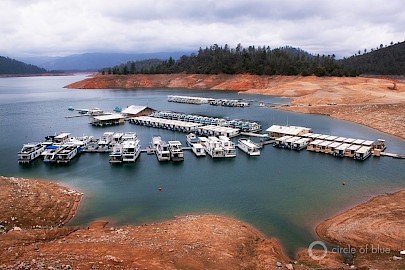Extremely dry conditions spill across the American West
 Spring is generally a time of renewal for the watersheds of the western United States.
Spring is generally a time of renewal for the watersheds of the western United States.
Warmed by the lengthening days, the region’s towering mountain ranges shed their mantle of snow, releasing freshets of water into welcoming streams and reservoirs.
This year, though, the cycle is in disarray. Outside of the Olympic and Cascade ranges of Washington state, winter snows were subpar. The spring melt has been a dud. From the Klamath to the Colorado and Rio Grande, watersheds are under stress once again, and water managers face difficult tradeoffs between farms, fisheries, and at-home uses. The main thing being renewed is concern over the seeming inadequacy of the region’s water supply.
“This is a drought emergency,” said Becky Bolinger, the Colorado assistant state climatologist.
Bolinger was referring to the latest runoff forecast for Lake Powell, a large reservoir on the Colorado River. The amount of water projected to flow into the country’s second-largest reservoir this spring and summer is 28 percent of the 30-year average. Dan Bunk of the Bureau of Reclamation said this year’s inflows are on pace to be the third or fourth lowest in the last century. Today, the lake is just 34 percent of capacity — or, looking at the math another way, about two-thirds empty. Downstream states like Arizona are bracing for mandatory cutbacks next year.
What is worrisome is that Bolinger could have been discussing any number of western watersheds.
In California on Monday, Gov. Gavin Newsom expanded a drought declaration to include 41 of the state’s 58 counties. Water levels in the state’s two largest reservoirs — Oroville and Shasta — are about half of what they usually hold this time of year.
In the Klamath basin of southern Oregon and northern California, there are already lawsuits over how the Bureau of Reclamation is allocating scarce water from Upper Klamath Lake. The drought is forcing the federal agency to balance the needs of endangered fish species both upstream and downstream. It told farmers in the upper basin to expect very little irrigation water this summer.
In New Mexico, water managers say the Rio Grande through Albuquerque could run dry this summer, which would complicate water management efforts. Mike Hamman, chief executive officer of the Middle Rio Grande Conservancy District, told Circle of Blue that his district faces a “three-pronged challenge:” delivering irrigation water to farmers, sending water downstream to Texas that is required under a federal compact, and protecting endangered species like the silvery minnow that rely on the river.
Dry conditions do not have uniform consequences, especially across so many states. According to Alvar Escriva-Bou, a research fellow with the PPIC Water Policy Center, California is better equipped to respond than it was during the last harsh drought, from 2012 to 2016. He said the metropolitan areas of Southern California are especially well positioned. These areas boosted conservation and reuse and have benefitted from longer-term investments in storage.
Still, with water so scarce, pain is inevitable. In the previous drought, thousands of residential wells in California’s Central Valley failed. PPIC estimates that nearly 2,400 shallow wells are at risk of going dry this summer. Farmers in the Central Valley, meanwhile, will need to fallow fields, pump groundwater, or buy water on the market after state and federal agencies cut their surface water allocation to the bone.
That these drought have been such a persistent problem raises a question. If conditions are dry nearly every year, is it really a drought? Or is it something altogether different? Academics, especially in the Colorado River basin, which has been drier than usual over the last two decades, assert that new language is needed.
Instead of calling these dry years a drought, they recommend the term “aridification.” Drought suggests a temporary departure from normal. Aridification implies that the region’s climate, under the influence of heat-trapping gases in the atmosphere, is entering a different reality.
“Warm droughts are especially challenging,” Escriva-Bou noted. Warmer temperatures increase the risk of wildfires, heat up streams to the point that fish cannot survive, and increase evaporation.
As in the Colorado River basin, precipitation in California this winter and spring was quickly eaten by a hot and thirsty atmosphere and dry soils.
Water managers like Grant Davis took notice. Davis is the general manager of Sonoma Water, a water agency that operates in California’s Sonoma and Marin counties.
Davis has managed water in droughts before. But the speed with which the dry conditions in his region intensified this year is something new, he said. “It’s come on faster, and it’s more dramatic and pronounced.”
You can return to the main Market News page, or press the Back button on your browser.

